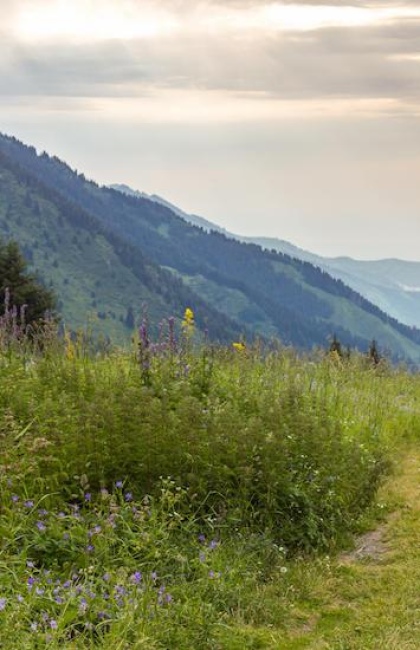Tien Shan Spruce: Kazakhstan's Endemic Evergreens
Timeless beauty and enduring legacy
The Tien Shan spruce, a subspecies of the Schrenk spruce, is endemic to the Tien Shan and Dzungarian Alatau mountain ranges in Kazakhstan and Kyrgyzstan. These magnificent trees have graced the region for centuries, captivating all who lay eyes upon them.
With trunks boasting a remarkable thickness of 2 meters (6.6 ft) in diameter and soaring heights of 60 meters (197 ft), the Tien Shan spruce holds a status as one of Kazakhstan's most symbolic and significant plants. Some sources suggest that these trees can live up to 500 years, though most often their lifespans are slightly shorter. Thriving as mid-mountain dwellers, they flourish at elevations ranging from 1300 to 3600 meters (~4300-12000 ft) above sea level. While the Tien Shan spruce cherishes sunlight, it also boasts a remarkable resilience to frost. Curiously, while sunshine accelerates the trees’ aging process, the cold temperatures facilitate an extended growth period.
Notably, the Tien Shan spruce showcases an elegant, elongated cone-shaped crown that distinguishes it from other conifers. During its prime, the spruce exhibits a vibrant and lush green color, which gradually transitions to a subdued gray as its life cycle nears its end. The bark of the tree is enriched with tannins, and during winter, its needles acquire an abundance of vitamin C, bolstering the tree's growth and fortifying its resistance against various diseases.
A mark on history
The Tien Shan spruce has made its mark on the history of Kazakhstan. Revered for its durability and strength, spruce wood was utilized by ancient Scythian tribes. Evidence of its value emerged within the Besshatyr mounds of the Altyn-Emel National Park, where a wooden structure constructed from Tien Shan spruce was discovered. Furthermore, this prized wood was employed in the construction of the burial chamber for the world-renowned Golden Man found within the Issyk burial mounds.
.jpg)
Beyond the appreciation of Scythian tribes, Tien Shan spruce played a significant role in the foundation of the city of Almaty. During the establishment of the city in 1854, spruce wood was frequently employed in the construction of buildings. In the Malaya Stanitsa area, many of the surviving historic houses from the late 19th to early 20th centuries were built using this remarkable wood. The resilience of these structures became evident during an earthquake in 1887 when most of the buildings in Verny (now Almaty) were reduced to ruins. However, those constructed from Tien Shan spruce remained relatively unscathed, leading to the increased use of these trees. Recognizing the need to safeguard this natural treasure, the Almaty Nature Reserve was established in 1931.
The Tien Shan spruce was also the primary material in the magnificent Ascension Cathedral in Almaty, a historical monument renowned for its architectural beauty. Additionally, spruce wood has graced the captivating pink house of the merchant Ibragimov.
While Tien Shan spruce forests are limited in their distribution, they remain highly sought after for landscaping parks and green spaces. For those unable to venture into the mountains, an enchanting alley of Tien Shan spruce trees along Tulebayev Street in Almaty offers a mesmerizing glimpse of their splendor. This very alley even made an appearance in the film «The Needle», starring the legendary punk-rock singer Victor Tsoi.
The Tien Shan spruce forests stand as a realm of awe-inspiring beauty, where the tantalizing aroma of pine needles fills the air, and the sheer grandeur of the trees evokes a profound connection with nature. These majestic evergreens continue to enrich the landscape and captivate hearts.
Interesting facts about the Tien Shan spruce:
- Roots: The Tien Shan spruce epitomizes the incredible strength that unity can bring. Growing on the steep slopes of mountains, these resilient trees have evolved not only main roots but also anchor roots. Deep beneath the surface, these anchor roots embrace obstacles such as stones and the roots of other trees, fortifying their position and ensuring stability. Moreover, Tien Shan spruces often intertwine their roots, creating a network that amplifies their collective strength, enabling them to withstand the formidable mountain winds.
- Family: In the face of the harsh mountainous terrain, the spruce has devised a remarkable strategy for survival and propagation. Lower branches, sustained by the nourishment of the main trunk, gradually extend upward and establish new root systems. This process can continue over an extended period, resulting in an extraordinary phenomenon encountered in the mountains – a spruce family. In these breathtaking displays, an ancient, weathered tree stands as the patriarch, encircled by a generation of young and green offspring.
- Moisture Regulators: Forests are renowned for their ability to retain moisture in the soil. The Tien Shan spruce, surpassing even its European counterparts, possesses a remarkable capacity to retain up to 70% of the precipitation it receives. This astonishing ability makes these forests crucial participants in the intricate water cycle of nature. By preserving substantial amounts of moisture, Tien Shan spruces contribute significantly to the sustained flow of mountain rivers and the preservation of pristine lakes.


-1_420x650_4ab.jpg)





